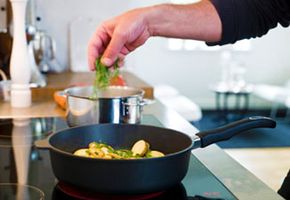Key Takeaways
- Eco-friendly cooking involves sustainable practices.
- It includes using local and seasonal ingredients, reducing food waste and minimizing energy consumption.
- Adopting these tips can help lessen the environmental impact of cooking.
Going green is rapidly becoming the norm, and the kitchen is a great place to start making environmentally friendly changes to your lifestyle. From the food you buy to the way it’s cooked and stored, you can save energy, reduce your carbon footprint and keep an eye on your budget in many different ways.
Eco-friendly cooking not only benefits the environment; it’s healthier for you and your family, too. Choosing organic vegetables keeps chemicals out of your body, as well the air, soil and rivers.
Advertisement
Many eco-friendly habits are also budget friendly. And these days, who isn’t watching every penny? Finding ways to cook more efficiently -- like using the right appliance for the job -- can help you reduce monthly energy costs. And you can cut your total supermarket bill by reusing products like aluminum foil and glass containers, buying and cooking food in larger quantities and making the most of leftovers.
Read on to discover our top 10 eco-friendly cooking tips.
